| |
 |
|
|
|
| |
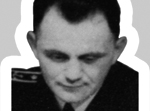 |
Chief Boatswain
Franz Miodonski
Seaman
* 4.1.1907 in Leschnitz (Silesia) - † 27.5.1941
|
 |
|
|


Germany (1907)
Source:
Horst Engelbrecht † (Son) / Prohn
|
Franz Miodonski was born on January 4, 1907 in the small Upper Silesian town of Leschnitz. He was the son of Franz and Marie Miodonski, and was baptized with his father's name. He spent his childhood in Leschnitz, one of the oldest towns in Silesia, located about 30 kilometers southeast of the city of Oppeln, and experienced the beginning of the First World War as a seven-year-old schoolboy. At the age of 18, the boy, who was raised Catholic, applied to join the German Navy. In addition to the prospect of a recession-proof job in the still relatively young post-war period, it was above all the promise of seeing a bit of the world in the navy that strengthened Franz Miodonski's resolve. But it was not easy to be accepted into the German Navy, which had only been founded four years previously. A few years earlier, the ranks had to be thinned out in order to meet the requirements of the Treaty of Versailles with a navy of only 15,000 men. Since there were now more than enough applicants, the recruitment process was made more difficult. Franz Miodonski, a slim, athletic young man, was still able to meet the requirements and was accepted. In 1925, he began his service in the Reichsmarine. The basic training that followed was just as tough as the recruitment tests. For Franz Miodonski, it was the start of a long career in the navy. He quickly found joy and fulfillment in his service as a professional soldier.
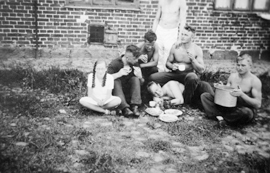
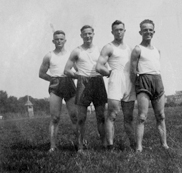
After about five years, he took a petty officers course in the early 1930s, taking him to the next level of his career. He successfully completed the course and, as a newly promoted petty officer, he became an instructor himself. During this time, Franz Miodonski met and fell in love with Erna Engelbrecht, the sister of a soldier he had trained. Soon after, she moved to Kiel to be closer to her "Mio", as she called him by her nickname, but he was constantly at sea with his new command, the battleship Schleswig-Holstein.
|
|
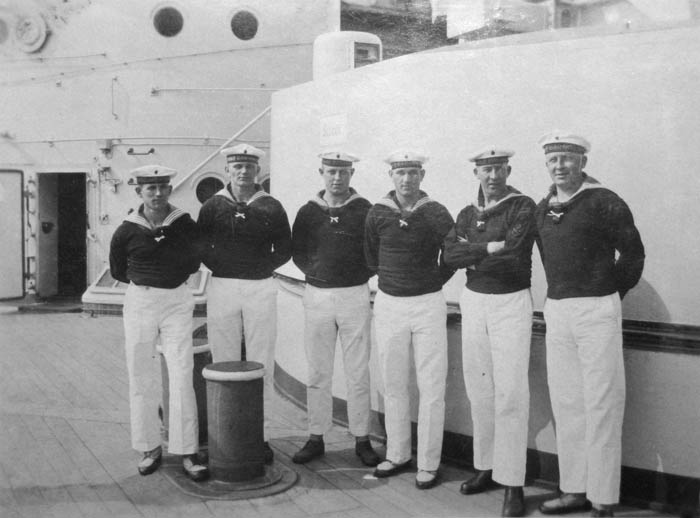 Franz Miodonski (2nd from left) with other petty officers at the aft gun turret of the Schleswig-Holstein |
|
|
In 1933, the unmarried couple had a son, whom they named Horst, who took his mother's surname. In the same year, Franz Miodonski was once again at sea on the Sophie X, as the old battleship Schleswig-Holstein was affectionately called by its crew. This time, the voyage in the summer of 1933 took him from Kiel to Oslo and from there, after a week, through the impressive western Norwegian fjord landscape to Ulvik, near Bergen, where the battleship anchored for another four days. The small town, surrounded by rocky mountain slopes and overgrown with rustic vegetation, left a deep impression on him. "No comparison with little Kiel," he said appreciatively.
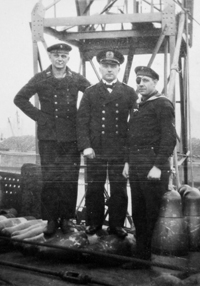 But the relationship suffered greatly from the constant separation for work reasons and so the two, who had never married, grew apart. Erna Engelbrecht had never really been able to get a foothold in Kiel and suffered from severe homesickness. Eventually she moved back to her hometown of Prohn, a small village on the Pomeranian Baltic coast. Her mother kept telling her that she should have stuck it out, but it was simply not possible for her. Since Erna Engelbrecht now had to work during the day, her son Horst grew up with his grandmother and experienced a rough but good upbringing, as he later recalled. He had hardly any contact with his father. It was only later, after his death, that a strong emotional relationship with his father developed.
But the relationship suffered greatly from the constant separation for work reasons and so the two, who had never married, grew apart. Erna Engelbrecht had never really been able to get a foothold in Kiel and suffered from severe homesickness. Eventually she moved back to her hometown of Prohn, a small village on the Pomeranian Baltic coast. Her mother kept telling her that she should have stuck it out, but it was simply not possible for her. Since Erna Engelbrecht now had to work during the day, her son Horst grew up with his grandmother and experienced a rough but good upbringing, as he later recalled. He had hardly any contact with his father. It was only later, after his death, that a strong emotional relationship with his father developed.
Franz Miodonski tried to keep in touch from Kiel, at least by letters. He had decided to join the navy rather than start a new career, and had to live with the consequences of his decision. His career continued, he became petty officer, second class and joined the crew of the new Panzerschiff Admiral Graf Spee in Wilhelmshaven at the end of September 1935. Three months passed before the new Panzerschiff was commissioned, a few days after the New Year and Franz Miodonski's twenty-ninth birthday. Another five months of trials and training were to follow before the ship was accepted into the fleet.
Then Franz Miodonski set off on another long voyage. Combat exercises were carried out off the Canary Islands. From Tenerife he wrote a postcard to Erna Engelbrecht and used the short stay in Kiel to visit her. In mid-August 1936 he set off for foreign waters again. This was to be Franz Miodonski's first war mission, sailing towards the Mediterranean on the Admiral Graf Spee as part of the international naval blockade against Spain, which was in the midst of a civil war. In addition to fulfilling his mission, there was also enough time for several port visits along the Spanish and North African coasts.
Back in Kiel, Franz Miodonski attended a boatswain course and was promoted to boatswain in November 1936, thus raising him to the rank of non-commissioned officer with swordtail. He only missed the pretty sailors uniform with the Kiel collar and the wide sailor's trousers that could be buttoned up at the front, which he had worn as a sailor and later as a petty officer. As a boatswain, he exchanged these for a suit with a tie and collar. He stayed on land until New Year's Day 1937, then went back on board and once again to Spain.
|
|
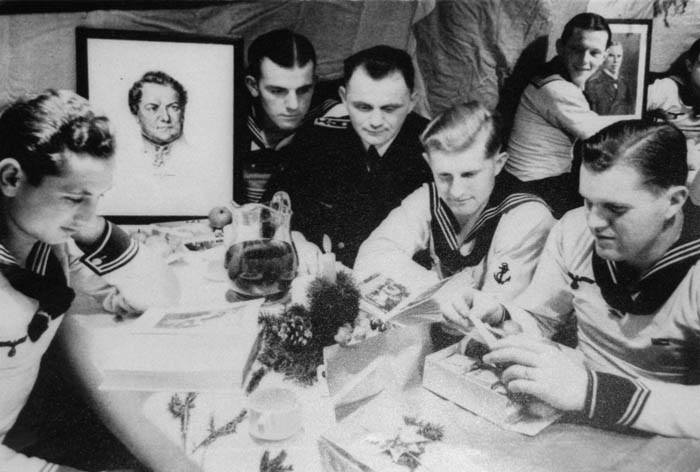 Christmas 1939, Chief Boatswain Franz Miodonski (3rd from left) celebrated in the accommodation deck with his mates from the battleship Gneisenau |
|
|
In the autumn of 1938, a new command followed on the battleship Gneisenau, which had only recently been commissioned and was still undergoing trials. Franz Miodonski began his service there in the 2nd Division and was later promoted to chief boatswain. On board the Gneisenau he experienced the beginning of the war, as well as the first missions in the North Sea and Atlantic. Erna Engelbrecht surprisingly discovered him in a photo in the newspaper. There he could be seen sitting lost in thought during the first Christmas of the war surrounded by his subordinates, with whom he had a good relationship. When Franz Miodonski was commanded on the battleship Bismarck in around 1940, he could already look back on 15 years of service, most of them on board large warships. He was one of the 15 longest-serving non-commissioned officers on board the Bismarck and, at 33 and later 34 years of age, was well above the average age. Franz Miodonski did not survive the sinking of the Bismarck. He died on May 27, 1941.
|
|
|